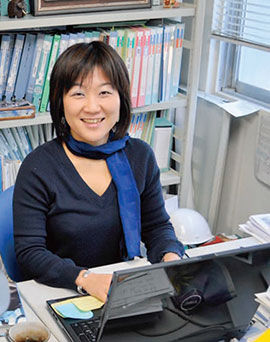
How to survive in the cities of the globalization era.
– Changing urban dynamism with complexity –
The 21st century is said to be the “Asian Century”, and at the same time, the “Urban Century”. In 2008, the urban population exceeded 50% of the global population (or approximately 3.3 billion). It is said that the world’s urban population will expand to approximately 5 billion by 2030 and 80% of which will be concentrated in the cities of developing countries and middle income countries. The majority of the increasing urban population in these countries are deemed to belong to the poor. How can these people survive in the cities? Will it be possible to ensure decent housing and to secure occupations? These issues will become more crucial in the future.
I have been researching mainly Thailand as a field until now. Bearing in mind that theories, policies and actual conditions are entangled, I am analyzing urban development and changing dynamism for macro-analysis, transition and performance of urban poverty policies. However, the actual working and living conditions of the urban poor are not fully contained in the official statistics, and therefore, field works are essential. I have been conducting long-term field works that focus mainly on occupations and residences of the urban lower class communities in Bangkok. Under the circumstances where the social security system is insufficient, I clarified, from the standpoint of the local people, how the risk response process of the people take place, which reorganization of stratification within community follows, and, community function to absorb the impacts from risks. Amid the interaction among individuals, households, community and society (including policies), I would like to feature the changing urban dynamism with complexity.
Faculty of Economics
Associate Professor, Asian economy, Thai Study
Born on December 19, 1975
| 1999 | Graduated from the Faculty of Law, Kyoto University |
| 2004 | Earned credit for doctoral course of Graduate School of Economics, Kyoto University |
| June 2003 – June 2005 | Visiting researcher at Chulalongkorn University Social Research Institute: CUSRI |
| 2004-2007 | Research fellow (PD) of the Japan Society for the Promotion of Science (Center for Southeast Asian Studies, KyotoUniversity) |
| 2007 | Obtained a PhD in Economics (Kyoto University). Researcher in the Center for Southeast Asian Studies, Kyoto University |
| 2008- | Current position after being a lecturer at the Faculty of Economics, Saitama University |
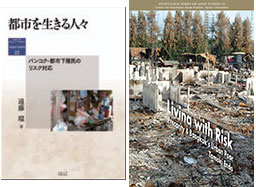
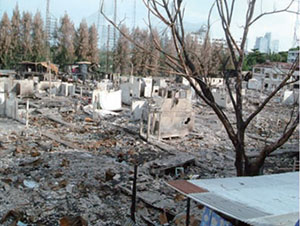
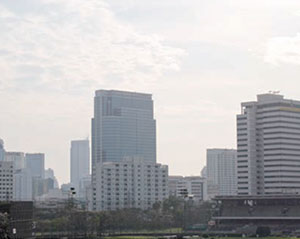
Main research site completely burned down in 2004, Bangkok cityscape
and approximately 8,000 people were burned out
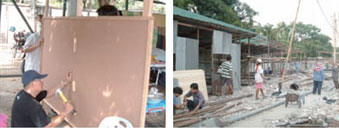
Temporary housing built by residents themselves
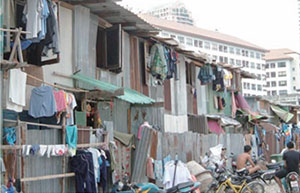
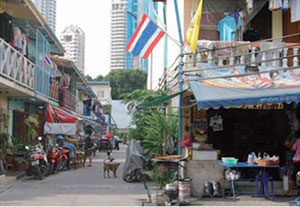
Temporary housing Community after restoration
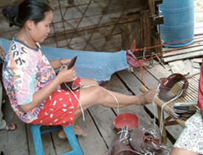
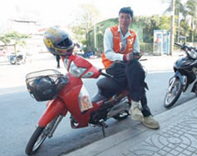
Shoes homeworker Bike taxi
The city grows and changes rapidly during globalization. My main field site, the capital of Thailand, Bangkok, is the financial and production centre with a row of high-rise buildings. On the other hand, when you step into an alley, a closely-spaced community extends. The sidewalk in front of a high-rise building is lined with food stalls, and bike taxis are driving through a traffic jam. While white collar foreigners who work for Japanese or Western companies stride along, immigrant workers flow in from neighboring countries such as Myanmar, and work in called 3D sectors of the city.
As the globalization advances, it is important that, instead of step-by step development, ‘compressed change’ is taking place at both developing and middle income countries. It bring about stratified structure of society and contemporary Asia is now facing with many challenges. It has not only specific challenges of developing and middle income countries, but also many challenges in common with Japan, such as an aging population and low birthrate.
The work and life of the urban lower class are vulnerable to various risks. (For example, layoff, fire, disease, accident, etc.) Under the circumstances where the social security system is inadequate, there are people who survive in a city, making full use of the resources available to them. Community is not only a place for habitation, but also functions to absorb risks, as a place for labor, life and consumption. Today, with an advancement of globalization and an increase of uncertainty, it is important that the approach to “poverty” is not static (i.e. whether people have enough money at a certain point of time or not ), but the approach should be dynamic (i.e. how to handle a risk when it is encountered should be addressed). Adding to that we have to aware that disparities within the urban lower classes are also widening and the community is not homogeneous. Today, it is becoming important to mutually share experiences among developing, and middle income and developed countries.
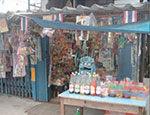
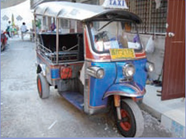
Grocery shop in the community Tricycle(Tuktuk)

Community activity (Ceremony for purifying a building site)


© Copyright Saitama University, All Rights Reserved.